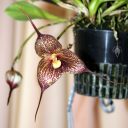Why Do Orchid Names Change?
Maybe you have a grasp on the complex world of orchid names, from reading nametags to understanding awards, plus all that Latin. Well, if you think you’re done, I’m sorry. You still have to deal with orchid name changes. Why do names change? Sorting out family ties between 30,000 orchid species is no easy task, and new discoveries constantly affect our interpretations. The onset of DNA analysis in the last few decades has revealed new relationships, and disproved others. It can be annoying, but it’s the inevitable result of continuing scientific research. Name changes are part of our growing understanding of orchids.
Here are three examples of name changes:
Shown in the first photo above, Japan’s beloved Samurai Orchid, Neofinetia falcata, has been renamed Vanda falcata. It’s long been known that Neofinetias and Vandas are closely related, because they can hybridize with each other. However, as scientists investigated further, they discovered that Neofinetias are, in fact, Vandas. Since it takes years, or even decades, for these updates to become widely known, it’s no surprise that many orchid lovers still say Neofinetia.
Draculas used to be called Masdevallias, until botanists realized that they were distinct enough to merit their own genus. Draculas were separated from Masdevallias in 1978. If you look at an old orchid book, you may find Dracula gorgona, in the second photo above, labelled as Masdevallia gorgona. An old orchid name is called a synonym of its new name.
The big, beautiful Cattleya in the third photo is a complex hybrid. One of its parent species was renamed from Brassavola digbyana to Rhyncholaelia digbyana. That affects its hybrid name. It went from being a BLC (Brassolaeliocattleya) to an RLC (Rhyncholaeliocattleya.) The “Brasso-” beginning of that long word became “Rhyncho-“. Since that same species is in the parentage of many Cattleya hybrids, this one renaming created a cascade, altering thousands of names.
Is your head spinning from this yet? Name changes are such a big, messy topic that there’s plenty more to discuss. Go back to enjoying your flowers, and check for additional info in a future post.
Explore posts in the same categories: Orchid Names, Photos
Subscribe to the About Orchids Blog:
![]()


